U.S. Department of Transportation
Federal Highway Administration
1200 New Jersey Avenue, SE
Washington, DC 20590
202-366-4000
Federal Highway Administration Research and Technology
Coordinating, Developing, and Delivering Highway Transportation Innovations
| SUPPLEMENTAL ARTICLE |
| This supplimental article is an archived publication and may contain dated technical, contact, and link information |
|
| Publication Number: N/A Date: July 2013 |
Publication Date: July 2013
|
This article is a continuation of the article printed in Public Roads magazine. Because of space limitations, the magazine was not able to print this supplement. Go to the online version of the article at https://www.fhwa.dot.gov/publications/publicroads/13julaug/03.cfm.
The National Interregional Highway Committee’s 1943 report to Congress, Interregional Highways, depicted urban expressways as fitting harmoniously into the Nation’s cities. The plates below, with their original captions, show how they worked:
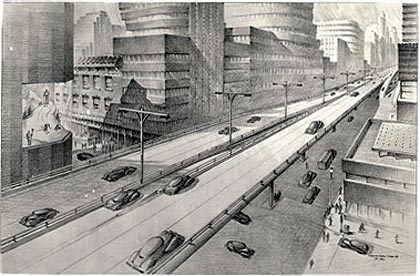 |
| Plate VIII: An elevated section of the interregional system as it might be built according to the standards proposed, with central exit ramps and lateral entrance ramps. The sketch suggests the manner in which new properties might conform to curving lines of the expressway in widened sections at access points, and a shop window at the elevated level dressed appropriately with the kind of large display that would be needed for comprehension by express traffic. |
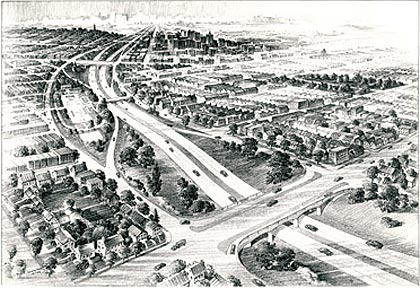 |
| Plate X: Built within a block-wide right-of-way, on a gently rolling grade, depressed to pass under bridges at important cross streets and rising to normal ground level between, with varied media strip width and use of border areas for suitable neighborhood recreational purposes, a section of the interregional system traversing residential areas of a city, conforming in all respects to standards proposed by the committee, is shown in this sketch. |
Once construction began, the expressways often proved disruptive and controversial.
During the period leading up to the Federal-Aid Highway Act of 1973 and through its subsequent implementation, the Federal Highway Administration (FHWA) had three Administrators:
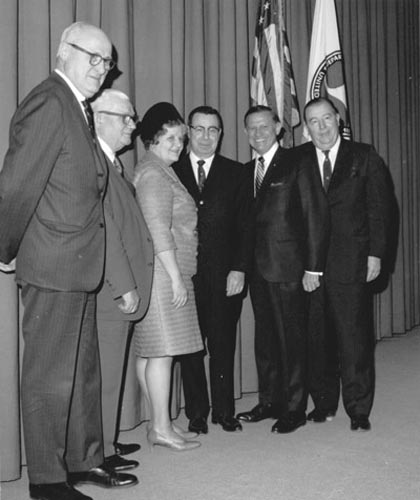 |
| Francis C. “Frank” Turner was sworn into office as Federal Highway Administrator on March 19, 1969. Attending the ceremony were (left to right) Representatives George H. Fallon and John C. Kluczynski of the House Public Works Committee, Mrs. Mabel Turner, Administrator Turner, Secretary of Transportation John A. Volpe, who administered the oath of office, and Senator Jennings Randolph of the Senate Public Works Committee. |
Francis C. “Frank” Turner. The only career employee to become Federal Highway Administrator, Turner joined the agency in 1929 and became Administrator in 1969. In the 1950s, he worked with General Lucius Clay’s committee to develop President Dwight D. Eisenhower’s “grand plan” for highway improvement. Turner also worked closely with the House and Senate Committees on Public Works as they developed the Federal-Aid Highway Act of 1956 that launched the interstate program. He was involved in implementing the program during the remainder of his career. A strong highway advocate, he favored highway-oriented transit instead of rapid rail transit for all but the largest cities. He retired in June 1972 but remained a strong voice for highway transportation in his later years.
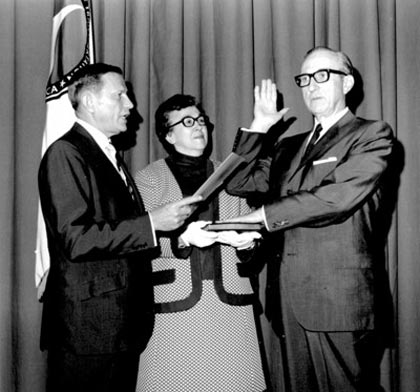 |
| On May 8, 1969, Secretary of Transportation John A. Volpe administered the oath of office to Director of Public Roads Ralph R. Bartelsmeyer, whose wife Marjorie held the Bible. |
Ralph R. Bartelsmeyer. Upon Turner’s retirement, Deputy Administrator Bartelsmeyer became Acting Administrator. An Illinois native, he rose through the ranks to become chief engineer of the Illinois Division of Highways in 1953 and remained in that position until 1963. He became director of the Bureau of Public Roads (BPR) in 1969. When BPR was eliminated as an administrative office within FHWA, he became deputy administrator in 1970. He served as acting administrator until 1973, the longest stint by an acting administrator in FHWA history. Throughout this period, he reached out to State highway agencies as they adapted to the many changes, particularly in the environmental and planning fields, in the 1970s.
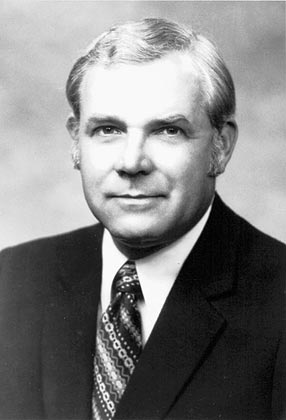 |
| Federal Highway Administrator Norbert T. Tiemann. |
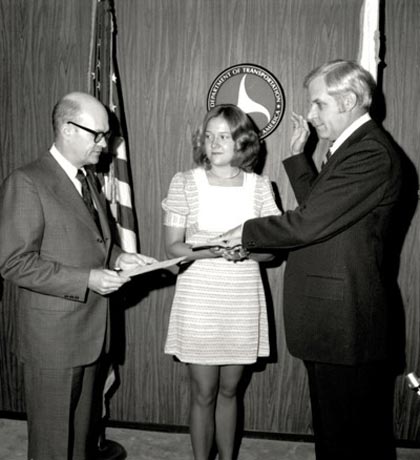 |
| Secretary of Transportation Claude S. Brinegar administered the oath of office to Federal Highway Administrator Norbert T. Tiemann on June 1, 1973. Tiemann’s daughter Mary held the Bible. |
Norbert T. Tiemann. A former activist Republican Governor of Nebraska, Tiemann took office on June 1, 1973, while Congress was completing work on the 1973 Act and just as FHWA was moving away from its traditional highway orientation to a balanced intermodal perspective. In response to the oil boycott that began in October 1973, “Nobby” -- as he was known to friends -- became a national leader in promoting the use of high occupancy vehicles (HOV) and exclusive HOV lanes, enforcement of the new 55 miles per hour (88 kilometers per hour) speed limit, expansion of transit to reduce driving, implementation of auto-free zones in central business districts, and other measures to save energy. He served during the remaining terms of Presidents Richard M. Nixon and Gerald R. Ford.
John A. Volpe. A Massachusetts native, Volpe was a rags-to-riches success story who built the Volpe Construction Company from an initial capital of $500 into a multimillion-dollar contractor specializing in heavy construction. The company was not a road builder but did construct the privately owned building that housed the U.S. Department of Transportation headquarters until June 2007. He served as the Massachusetts Commissioner of Public Works (1953–1956) before President Eisenhower selected him to be the first Federal Highway Administrator (1956–1957). He won an unprecedented four elections for Massachusetts Governor (1961–1963, 1965–1969) before becoming the Nation’s second Secretary of Transportation in 1969. After taking office, he said he was no longer a “Highway Man” or a “Transit Man,” but a “Transportation Man.” Considered one of the great Secretaries of Transportation, Volpe was honored in September 1990 when the Department’s research facility in Cambridge, MA, was renamed the John A. Volpe National Transportation Systems Center.
Claude S. Brinegar. Succeeding Secretary Volpe in 1973, Brinegar was an oil company executive who had no experience in government service or transportation, other than as a consumer. Before leaving office on February 1, 1975, he managed the Department through the Nation’s worst energy crisis, which began in October 1973, and the transition of the Federal-aid highway program to an intermodal perspective as reflected in the Federal-Aid Highway Act of 1973. Like his predecessor, Secretary Brinegar advocated flexibility to allow State and local officials to use some Highway Trust Fund revenue for highways or transit. After leaving office, he returned to the private sector, subsequently serving as leader of the Reagan transition team for transportation, and was later elected to the Conrail board of directors.